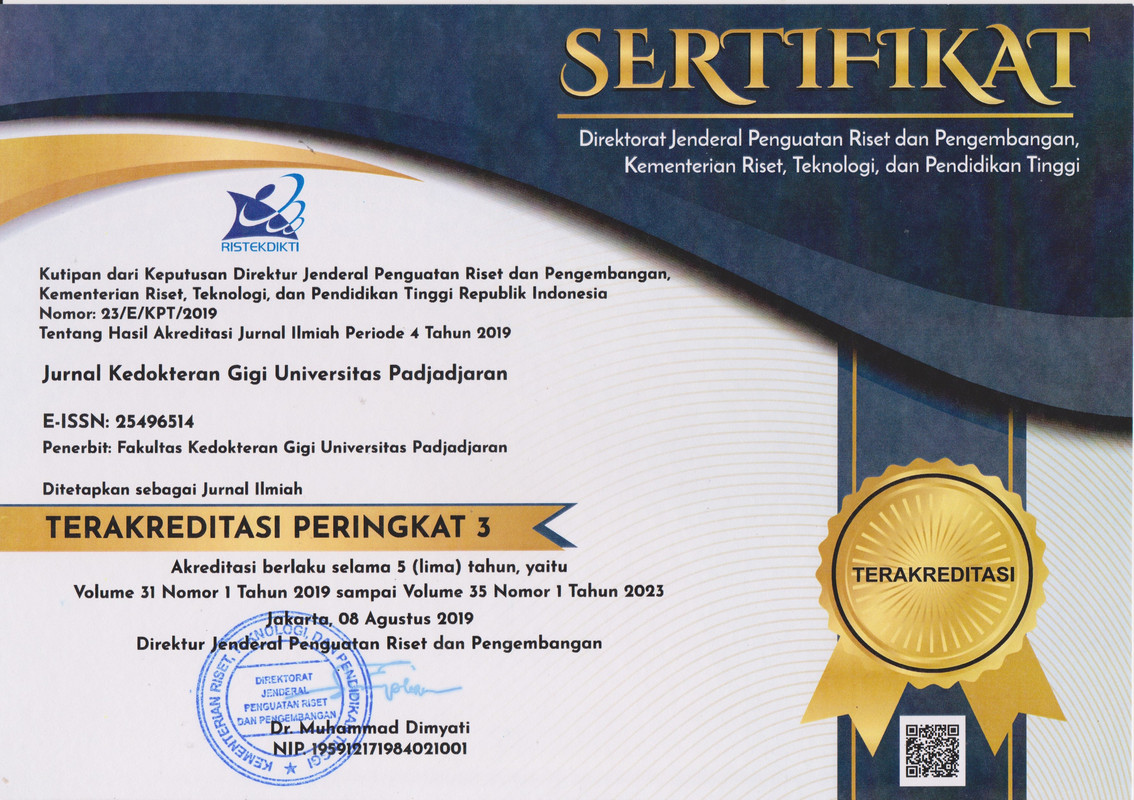Identifikasi relasi maksilomandibula rahang tidak bergigi lengkap
Identification of edentulous maxillomandibular relation classification
Abstract
Pendahuluan: Pasien tidak bergigi lengkap yang sudah terlalu lama, umumnya mengalami perubahan anatomi dalam rongga mulut seiring bertambahnya usia, termasuk perubahan pada relasi maksilomandibula, sehingga keadaan ini akan menambah tingkat kesulitan dalam perawatan. American College of Prosthodontic telah mengembangkan suatu sistem klasifikasi untuk membantu dalam menyusun rencana perawatan gigi tiruan lengkap yang terdiri dari beberapa kriteria diagnostik utama salah satunya adalah relasi maksilomandibula. Tujuan penelitian adalah untuk mengidentifikasi klasifikasi relasi maksilomandibula pada rahang tidak bergigi lengkap pada pasien di Klinik Prostodonsia RSGM FKG Universitas Padjadjaran (Unpad). Metode: Jenis penelitian ini merupakan penelitian deskriptif dengan teknik survei. Pengambilan sampel menggunakan teknik purposive sampling. Sampel penelitian didapat dari 20 artikulator yang sudah dipasang model kerja rahang tidak bergigi lengkap atas dan bawah. Relasi maksilomandibula didapat dari pemeriksaan artikulator gigi tiruan lengkap secara langsung yang sedang dikerjakan oleh ko-ass atau residen. Hasil: Klasifikasi relasi maksilomandibula kelas I ditemukan sebanyak 12 responden (60%), kelas II sebanyak 2 responden (10%), dan kelas III sebanyak 6 responden (30%). Simpulan: Klasifikasi relasi maksilomandibula kelas I sebanyak 12 responden (60%) merupakan relasi yang paling banyak ditemukan pada pasien rahang tidak bergigi lengkap di RSGM FKG Unpad.
Kata kunci: Rahang tidak bergigi lengkap, klasifikasi relasi maksilomandibula
ABSTRACT
Introduction: Patients with long period edentulous jaw, generally experience anatomic changes in the oral cavity as we get older, including changes in the maxillomandibular relation, so this condition will increase the level of difficulty in treatment. The American College of Prosthodontic has developed a classification system to assist in developing a complete denture treatment plan consisting of several main diagnostic criteria, one of which is maxillomandibular relations. The aim of the study was to identify the classification of maxillomandibular relations in edentulous patients at the RSGM FKG Prosthodontics Clinic, Padjadjaran University (Unpad). Methods: This type of research is a descriptive study with survey techniques. Sampling using purposive sampling technique. The research sample was obtained from 20 articulators that had been installed with a complete upper and lower toothless jaw working model. Maxillomandibular relation was obtained from direct complete denture articulator examination that was being done by co-ass or resident. Result: Classification of class I maxillomandibular relations was found as many as 12 respondents (60%), class II as many as 2 respondents (10%), and class III as many as 6 respondents (30%). Conclusion: Classification of class I maxillomandibular relationships as many as 12 respondents (60%) is the most common relation in incomplete toothless jaw patients at FKG Unpad RSGM.
Keywords: Edentulous jaw, maxillomandibular relation classification
Keywords
Full Text:
PDFReferences
American College of Prosthodontics. 2014. Facts and Figures. [Diakses 24 Sep 2014]. Tersedia pada: http://www.gotoapro.org/news/facts--figures/.
Badan Penelitian dan Pengembangan Kesehatan. 2013. Riset Kesehatan Dasar: Kementrian Kesehatan Republik Indonesia. [Diakses 20 Sep 2014]. Tersedia pada:http/www.litbang.depkes.go.id.
Zarb GA, Bolender CL, Carlsson GE. Biomechanics of the Edentulous State. in Prosthodontic Treatment for Edentulous Patients. 13th ed. St. Louis: Mosby. 2013. h. 6.
Mazurat RD, Mazurat NM. Communicating complexity: using a diagnostic calssification system for edentulous patients. J Cand dent Assoc 2003;69:511-3.
McGarry TJ, Nimmo A, Skiba JF, Ahlstrom RH, Smith CR, Kxoumjian JH. Classification system for complete edentulism. J Prostho 1999;8:27-39.
Notoatmodjo S. Metodologi Penelitian Kesehatan. Jakarta: PT Rineka Cipta. 2010. h. 125, 134.
Sukadana AA. Dasar-dasar Antropologi Fisik dan Phylogenesi Khusus untuk Ilmu Kedokteran Gigi di Indonesia. Surabaya: Unair. 1976.
Wihary F. Perbedaan Profil Lateral Wajah Berdasarkan Jenis Kelamin pada Mahasiswa USU Ras Deutro-Melayu. Medan: Universitas Sumatera Utara. 2012.
Singh G. Textbook of Orthodontics. New Delhi: Jaypee Brothers. 2007. h. 68.
Itjiningsih W. Geligi Tiruan Lengkap Lepas. Jakarta: EGC. 1993. h. 126-30.
Geering AH, Kundert M, Kelsey C. Complete Denture and Overdenture Prosthetics. 1st ed. New York: Thieme Medical Publishers. 2006. h. 8-11.
Bharathi M, Kethi RMB, Ghiridar R, Naveen G, Abhinav M, Vinod V. Partial edentulism based on kennedy‟s classification: an epidemiological study. J Contemp Dent Pract 2014;15:229-31.
Muneeb A, Khan BM, Jamil B. Cause and pattern of partial edentulism/exodontia and its association with age and gender: semi rural population, Baqai Dental College, Karachi, Pakistan. Internat Dent J Stud Res. 2013;1:13-8.
Thomson WM. Monitoring edentulism in older New Zealand adults over two decades: A review and commentary. Inter J Dentis 2012 ID 375407:4. [Diakses 24 Mei 2015]. Tersedia pada: http://dx.doi.org/10.1155/2012/375407.
Curtis DA, Curtis TA, Wagnild GW, Finzen FC. Incidence of various classes of removeable partial dentures. J Prosthet Dent 1992;67(5):664-7.
Enoki K, Ikebe K, Haeyama T, Ishida K, Matsuda I, Maeda Y. Incidence of partial denture usage and Kennedy calssification. J Prosthet Dent. 2008;26(2):264-8.
George B. Textbook of complete denture prosthodontics. New Delhi: CBS Publishers & Distributors. 2007. h. 20-1.
Johnson DL, Stratton RJ. Fundamentals of removeable prosthodontics. Illinois: Quintessence Publishing Co., Inc.; 1980. h. 29-32, 313.
Digital Object Identifier
DOI : https://doi.org/10.24198/jkg.v29i1.18604Dimension Citation Metrics Badge
Refbacks
- There are currently no refbacks.
Copyright (c) 2017 Jurnal Kedokteran Gigi Universitas Padjadjaran
INDEXING & PARTNERSHIP
Refbacks
- There are currently no refbacks.
Copyright (c) 2017 Jurnal Kedokteran Gigi Universitas Padjadjaran
INDEXING & PARTNERSHIP

Jurnal Kedokteran Gigi Universitas Padjadjaran dilisensikan di bawah Creative Commons Attribution 4.0 International License






.png)















